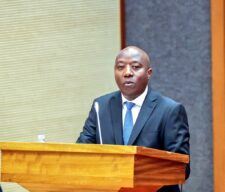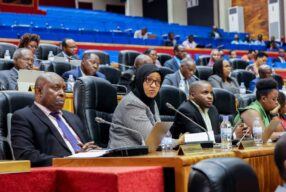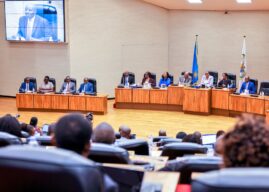
Prime Minister, Dr. Édouard Ngirente
The Prime Minister, Dr. Édouard Ngirente has stated that Rwanda is recovering from the impact of Covid-19 but with high possibilities that government subsidies which enabled cushioning the shocks will be scrapped soon.
Ngirente made the remarks on February 13, 2024 while presenting the status of the country’s progress on post-Covid-19economic recovery process to member of both Parliament- the Senate and Chamber of Deputies.
In his presentation, Ngirente showed that new projections indicate that the economy and inflation will grow steadily and reduce respectively.
Like many countries, the PM showed that Rwanda was equally affected by the pandemic which in general resulted in a negative impact in economic activities which resulted in -3.4% growth.
Ngirente said that the economy has in the last three financial years (2021-2023) seen an average annual growth of 8%. Since 2021 it grew at 10.9%, in 2022 at 8.2%, and a projected calculation based on the IMF, is that the results of 2023 (once the fourth quarter included) will come with a growth of 7% compared to the 6.2% growth projected.
“This is the growth of the gross domestic product (GDP) in our country was attributed to the increase in productivity in different sectors of the economy, especially the service sector,” Ngirente said.
Service sector productivity rose in an interesting way, moving from a rate of minus 6% in 2020 to 12% in the year 2021 and 2022.
Figures from the three quarters of 2023 show that the service has grown to a rate of 10.6% and expected to improve further.
This growth was caused by some of the increased activities in the sector, where information technology increased by 33.2%, education increased by 18.9%, transportation increased by 14.3% and hotels and hospitality activities grew at a rate of 18.3%.
“The hospitality sector was mainly driven by attracting key players in Meeting, Incentives, Conferences and Exhibitions (MICE) which continued to increase in the country,” Ngirente said.
The industry sector, which had dropped -4.2% in Covid-19, increased to 13.4% and 5% (in 2021 and 2022) and a 9.5% growth in three quarters of 2023- mainly driven by the construction activities which grew 9.4%.
This growth in the construction activities also boosted the local manufacturing sector by 10,5% (in three quarters of 2023) but also a growth in processed products, especially clothes and agro- products.
In the same period, the mining sector, which is the second source of forex income, grew by 12.1% due to reforms in the sector and increase in exported minerals to the international markets.
The mining sector earned $852million in the first nine months (Jan-Sept 2023) compared to $584.8 million in the last year (2022).
In the the National Strategy for Transformation (NST1) Rwanda has set an ambitious target for the sector to become a $1.5 billion industry by end of 2024.
Decline in agriculture production has especially been affected by climate change (2022 and 2023) but it tried the best in production despite long dry spells.
In 2021 the sector grew by 6% and decreased in 2022 by 2% but Ngirente said that the sector is seeing 3% in 2023 and this is expected to stay constant but with hard work in increasing cultivable land, use of agro inputs, with a new state-of-the-art fertiliser blending factory up and running in Bugesera district soon.
The plant will have a capacity of 120 tonnes per hour, equivalent to an annual output of 100,000 tonnes, exceeding Rwanda’s current annual demand of 85,000 tonnes, typically met through importation.
The company (Rwanda Fertiliser Company-RFC) behind the over $19.2 million project envisions a 40% increase in crop yields through a tailored formula that optimises soil health and nutrient balance.
With an anticipated to generate around 50 direct jobs, the plant aims to transfer expertise to enhance Rwanda’s skills in the fertilizer industry. As a result, it is expected to contribute to a 25% increase in farmers’ income, fostering economic empowerment and creating a ripple effect of positive change.

member of both Parliament- the Senate and Chamber of Deputies.
Subsidies To Be Scrapped:
Ngirente said that the government put in place mitigation mechanisms and products which include offering credit to the private sector (from Rwf 1.065,8billion to Rwf1.927billion representing an 81% increase.
He said that through the Economic Recovery Fund (ERF) the government has given various private sector players Rwf206,6billion of the Rwf459billion injected into the fund (ERF 1&2), established the Manufacture and Build to Recover Program (worth $2,38billion to support 136 projects to create 43,000 jobs) but also offered subsidies to cushioned the pandemic shocks in the transport and fuel activities which influenced increase in prices and inflation.
For instance from May to December 2021, the government injected subsidies on imported petroleum products worth Rwf23billion and till November 2023 this amount had reached Rwf91billion to avoid the impact of high and unstable global fuel prices on local businesses.
This was coupled with subsidies (0.73francs) on transport fares within Kigali and upcountry since 2018 to-date. However, following signs of recovery, PM Ngirente informed Rwandans to be prepared to see changes where these subsidies will be scrapped and the funds used for other development purposes.
Ngirente revealed that a technical team has been established to look into the numbers and way forward in scrapping the subsidies but also consider a few changes in the cost of fare paid on a trip so that it doesn’t pinch the common citizen.
Dr. Ngirente announced that in the last three years, Rwanda has created over 590,000 new jobs against the target to create 200,000 new jobs every year.
Ngirente also revealed that 860.000 citizens were employed under the VUP program, and 474.000 families affected by Covid-19 supported under the Social Protection programs.
Price inflation grew in 2021 and from the year 2022 and 2023 it increased from a rate of 1.9% to 21.6% but Ngirente said that projections for the end of 2023 show that prices will drop to 6.4% and expected to reach 5% (as of January 2024 projections).
In the meantime, Rwanda’s exports which dropped by 21% have not seen a tangible recovery though the volumes more than doubled (+107,8%) from $761,3billion to $1.582,3billion (2020-2023) while imports increased 56.4% with a value coming from $2.7billion to $4.2billion in the same period.
This has left Rwanda’s trade deficit wider and increased 36.6% from $1.9billion to $2.7billion in the same period.
PM Ngirente asked Rwandans to work hard and double efforts especially in the agriculture, manufacturing and industry to counteract this deficit.

A joint Parliamentary hearing (Senate and the Chamber of Deputies)

